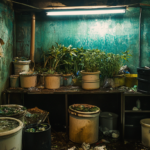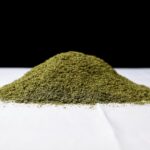Like other highly regulated industries, the cannabis industry has rules for properly handling and disposing of waste material. Unlike most other industries, the burden of cannabis waste treatment falls upon the generator—in this case, the commercial operator.
Let’s use California as an example. Of the three regulatory agencies that oversee commercial cannabis operations in the Golden State, only two—the Bureau of Cannabis Control (BCC) and the Manufactured Cannabis Safety Branch (MCSB) of the California Department of Public Health—have created unique waste requirements in an attempt to halt diversion and growth of the illicit market.
Commercial business types governed by the BCC and MCSB include manufacturers, distributors, retailers, testing labs, and microbusinesses (vertically integrated operations). The agencies have specified cannabis-containing material intended for disposal is considered “cannabis goods/product” until it has been rendered unrecognizable and unusable, at which point it becomes “cannabis waste.”
The BCC mandates:
- Cannabis goods intended for disposal shall remain on the licensed premises until rendered into cannabis waste.
- To be rendered as cannabis waste for proper disposal…cannabis goods shall first be destroyed on the licensed premises. This includes, at a minimum, removing or separating the cannabis goods from any packaging or container and rendering it unrecognizable and unusable. (Title 16 CCR, Division 42, § 5054. Destruction of Cannabis Goods Prior to Disposal)
Likewise, the MCSB dictates:
No cannabis product shall be disposed of in its packaging, and all cannabis waste shall be unrecognizable and unusable as cannabis or a cannabis product at the time of disposal. (Title 17 CCR, Division 1, Chapter 12 [MCSB], § 40290. Waste Management)
In other words, cannabis waste requires further treatment prior to disposal. An operator cannot simply throw unwanted cannabis waste into the municipal trash. And for good reason:
- Cannabis is still a Schedule I federally controlled substance.
- Products are intended for adult and/or medical use only, and if they were to end up in the wrong hands detrimental effects could ensue.
- At roughly one quarter of the price of gold by weight, cannabis is highly desired.
- Due to tight and costly oversight and taxes, the potential for illicit business is strong.
- Little is known about the environmental impact of large volumes of cannabis-containing material.
The rules apply only to businesses governed by the BCC and MCSB. Cannabis cultivators are not subject to these requirements.
Commercial cannabis cultivation is regulated by CalCannabis, a branch of the California Department of Food and Agriculture. CalCannabis has not specified any particular method for handling waste beyond what is outlined in the Public Resources Code governing regular garbage and trash. Cultivation waste (cannabis plant material) is considered organic waste and falls under regional waste franchise authority. This means a commercial cannabis cultivator can throw unwanted cannabis waste into their municipal trash bin.
The disparity between BCC, MCSB, and CalCannabis waste requirements is not only evident but also peculiar. Cannabis is a plant; it originates at the cultivation level. Why is a wasted cannabis flower regulated at the distribution level but not at the cultivation level? Once a flower has reached distribution, it already has been packaged and entered into track-and-trace. Its whereabouts are well-documented.
Step back in time to when that same flower was just picked off a plant, manicured, and thrown into a tray with 1,000 other flowers. This would seem to be the point in time with the highest risk of diversion to the illicit market, and surprisingly it is the point in time where the product is least regulated by the state.
This column focuses on rendering requirements set forth by the BCC and MCSB, collectively referred to as “the state.”
Besides providing the description “unrecognizable and unusable,” the state has not provided any procedural guidance about the means and methods of rendering. “Unrecognizable and unusable” is a result, but the process is open and up to generator determination. The state does not advise about nor judge the process but only assesses the result on a case-by-case basis.
In this context, the cannabis industry is similar to the pharmaceutical industry, but with some fundamental differences. Pharmacies commonly destroy wasted medications (i.e. pills and tablets) on site prior to disposal. Destruction involves mixing pills or tablets with a neutralizing liquid—a fairly easy process since they are small and water-soluble. Third-party service providers typically handle the task.
Compare that with the cannabis industry, which generates a wide variety of waste streams—including agricultural, consumable, cosmetic, laboratory, pharmaceutical, and medical—in copious quantities. These complex waste streams can be difficult to render properly as they require vastly different means and methods. Although they all contain cannabis, not all are regulated solely by the state. Authority often overlaps with other regulatory agencies like the Department of Toxic Substances Control and the Environmental Protection Agency.
Even the term “unrecognizable and unusable” is a bit vague. Unrecognizable by sight, touch, or smell? Unusable, meaning immediate use? Un-consumable? Un-manufacturable? The ambiguity provides generators with a lot of freedom, which may not always be a good thing.
There are no universally recognized protocols for rendering cannabis waste, only general guidelines and common industry practices. For instance, a common industry standard looks something like this:
1. If applicable, separate wasted goods from container/packaging and accumulate in rigid container.
2. Grind waste material to a particle size of approximately one-half inch.
3. Blend material with at least 50 percent other—non-cannabis containing—solid, by weight. (The 50-percent blend protocol was described in early 2018 Emergency Regulations. This step has since been removed from Final Regulations as of January 2019.)
4. Saturate material with approximately 20 percent liquid, by volume.
5. Compress or compact material to at least 50 percent of original volume.
The above suggestion is not a regulation, just an industry standard—one the industry has adopted not because it is a requirement, but because it consistently will yield a desired outcome.
There are many ways to render cannabis waste. One might use hand tools such as pickaxes and shovels, or they might use heavy equipment such as grinders, shredders, and compactors. Cannabis can be altered physically or chemically.
Physical alteration might comprise grinding, compacting, and blending, changing the product’s physical form. This would serve to make the cannabis unrecognizable. Chemical alteration might involve heating, dissolving, and mixing with neutralizing chemicals. By adding a strong acid or oxidizer to cannabis, it’s possible to strip apart the THC molecules. This would make the product unusable.
There are safe ways of rendering and, of course, not-so-safe ways. Utilizing hazardous materials and chemicals is an example of the latter. Industry folklore tells of a generator mixing their wasted cannabis flower with hydrochloric acid in a steel drum. The acid ate through the drum, contaminating the facility and becoming a hazard to employees.
The majority of generators have good intentions; they’re simply trying to abide by vague state requirements. But sometimes they inadvertently create other hazards and break other rules.
In California:
Treatment means any method, technique, or process, including neutralization, designed to change the physical, chemical, or biological character or composition of any hazardous waste so as to neutralize such wastes, or so as to recover energy or material resources from the waste, or so as to render such waste non-hazardous, or less hazardous; safer to transport, store, or dispose of; or amenable for recovery, amenable for storage, or reduced in volume. (40 CFR § 270.2 – Definitions)
Prior to rendering waste, the generator must make a solid effort to determine whether the waste is hazardous. If the waste is hazardous, rendering it according to state cannabis regulations may put the generator in violation of federal regulations. The feds view “rendering” as “treatment,” and the unpermitted treatment of hazardous waste can result in hefty fines and even jail time.
Industry folklore recounts the tale of a generator who wanted to dispose of single-use vaporizer pens with internal batteries. The all-in-one pens carried a cannabis oil cartridge, so the generator assumed they needed to follow state rendering requirements. However, the pens were not easy to disassemble. Without any guidance, the generator decided to saw the pens apart one-by-one, isolating the oil cartridge. The high-speed saw cut the end off of a battery, causing it to discharge and ignite the other batteries in the drum. The smoke and fire triggered a response by emergency services, and officials subsequently determined that by saw-cutting the pens, the generator violated federal regulations.
Another bit of industry folklore tells of a generator who removed wasted gummies from their packaging, consolidated them in a small drum, and saturated the collection with bleach. A few days later, an employee discovered the gummies in an outdoor trash receptacle, dried out and odorless. Fortunately, the employee was aware of the gummies’ fate, but had someone else found the treated edibles and eaten them, that person could have become seriously ill.
Generators face numerous pitfalls as they attempt to manage their waste properly. Commercial cannabis businesses are not experts in waste treatment, and they should not be expected to act as such. Their primary business is the manufacture, distribution, and sale of cannabis. They do not have the necessary knowledge, personnel, equipment, or facilities to render all the potential waste streams they generate.
This is why many generators choose to hire cannabis waste management consultants or service providers to assist with the process. These providers have developed safe, secure, and efficient methods of onsite rendering. Some providers utilize heavy equipment that can process more than 10,000 pounds of material in a single eight-hour shift. They capture video documentation and provide signed certification of the finished job. Third-party service and oversight removes both burden and liability.
Garrett Rodewald is co-founder and chief operating officer at cannabis waste solutions provider Gaiaca. Equal parts scientist, outdoorsman, and entrepreneur, he possesses more than a decade of experience and training in Environmental Protection Agency and Occupational Safety and Health Admininstration compliance, environmental health and safety, and hazardous materials management.












